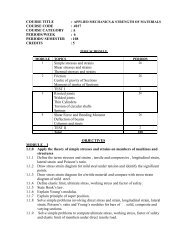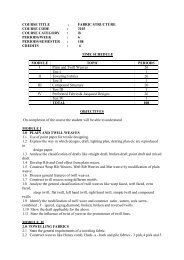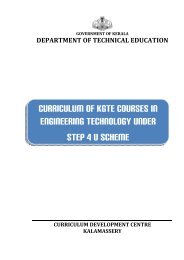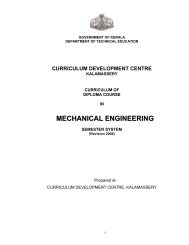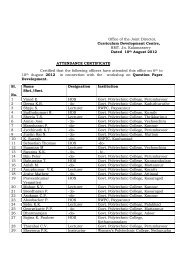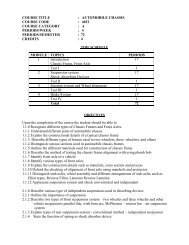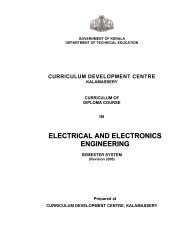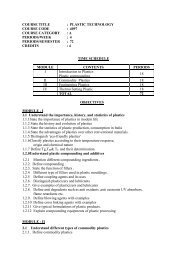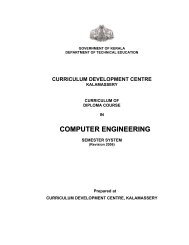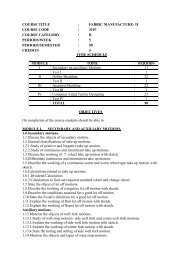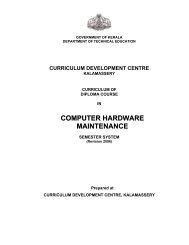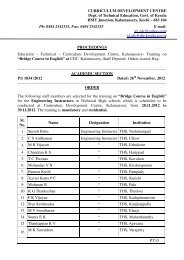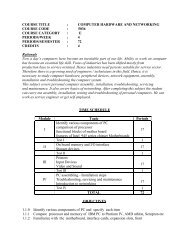23 - Curriculum Development Centre, Kalamassery
23 - Curriculum Development Centre, Kalamassery
23 - Curriculum Development Centre, Kalamassery
Create successful ePaper yourself
Turn your PDF publications into a flip-book with our unique Google optimized e-Paper software.
UNIT – V5.1.0 Use computer graphics in ‘C’ language to prepare programs5.1.1 State the use of graphics.h5.1.2 Define resolution5.1.3 Discuss the functions initgraph(), setcolor(), setbkcolor(), putpixel(), line(), circle(),rectangle(), outtexty()5.1.4 Write programs based on graphics5.2.0 Understand new trends in information technology5.2.1 Define the work ‘multimedia’5.2.2 Define the word ‘multimedia’5.2.3 Discuss the components required for a multimedia personal computer5.2.4 Define computer network5.2.5 Define LAN, WAN5.2.6 Discuss the concept if Server and nodes5.2.7 Discuss Internet, World Wide Web, and e-mail5.2.8 Discuss Computer virus and anti-virus programs5.2.9 Define artificial Intelligence and discuss its application fieldsCONTENT DETAILSUNIT – I Introduction to Computers & Word ProcessingIntroduction, application of computers, generations of computers, classification of computers –analog, digital, hybrid Computers, Structure of a computer - Hardware and Software components –Input unit, Output unit, ALU, Memory unit, Control unit, CPU, Microprocessor, micro, mini,supercomputers – machine languages, assembly languages, high level languages – system soft ware,application software – assembler, compiler, operating system – Types of memory – primary memory,secondary memory, sequential access , random access memory, RAM, ROM – magnetic tape, floppy,hard disc, compact disc – input devices, out put devices.Practical sessions on Windows O/S, Word, Power pointUNIT – II Data Processing and Programming MethodologyPractical session on Electronic spread sheet and DBMS – EXCEL, ACCESSSteps in problem solving – Algorithm, Flowchart- Flow chart symbols- examples syntax, semanticstypesof high level languages – characteristics of high level languages - Types of high level languages– Examples – Procedural and object oriented programming languagesUNIT – III Introduction to C ProgrammingCharacteristics of C-language – structure of a program header files, main (), Statements, compoundstatements, Data types – Keyword and variables, assignment operators, arithmetic operators,expressions, precedence of operators, order of evaluation – relational and logical operators - Input/out put statements -– control sequences – escape sequences – branching statements, if, if-else, switch– looping statements while, do, for statements.Writing Sample programs – Practical session on programmingUNIT – IV Arrays and FunctionsArrays – declaration, processing, searching, sorting – linear search, bubble sort – multi dimensionalarrays- matrix manipulations, character strings, string declaration, input/out put functions gets (), puts(). User defined functions – library functions – structure of functions, calling functions, argumentpassing, void functions – mathematical and string library functions – math.h, stdio.h, string.hWriting programs – Practical session on programmingUNIT – V Graphics and NetworkingC-Graphics – resolution – graphics functions – initgraph (), setcolor (), setbkcolor (), putpixel (), Line(), circle (), rectangle (), out text (), outtextxy ()Multimedia – Computer networkingLAN, WAN- Internet, modem, www-E-mail, computer virus, artificial intelligence.REFERENCE BOOKS1. Brian w. Kernigham and Dennys M. Ripchie The ‘C’ programming Language PHI2. Hughes J. K. and Michton J. I. A structured approach to Programming PHI3. Gottfried.B Theory and problems Programming with C TMH46



